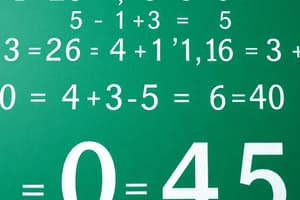Podcast
Questions and Answers
What is the result of the operation $5 - 2$?
What is the result of the operation $5 - 2$?
- 3 (correct)
- 2
- 7
- 0
Which property states that the order of numbers in addition does not change the result?
Which property states that the order of numbers in addition does not change the result?
- Identity property
- Associative property
- Commutative property (correct)
- Distributive property
Which of the following sets includes both positive and negative whole numbers?
Which of the following sets includes both positive and negative whole numbers?
- Natural Numbers
- Whole Numbers
- Integers (correct)
- Rational Numbers
What is the result of $2 × (3 + 4)$ using the distributive property?
What is the result of $2 × (3 + 4)$ using the distributive property?
Which of the following correctly identifies a fraction with $1$ as the numerator and $2$ as the denominator?
Which of the following correctly identifies a fraction with $1$ as the numerator and $2$ as the denominator?
What is the simplification of the fraction $4/8$?
What is the simplification of the fraction $4/8$?
Which number is irrational?
Which number is irrational?
What is the first step in the order of operations according to PEMDAS?
What is the first step in the order of operations according to PEMDAS?
Flashcards
Addition
Addition
Combining numbers to find their total.
Subtraction
Subtraction
Finding the difference between two numbers.
Multiplication
Multiplication
Combining equal groups of numbers.
Division
Division
Signup and view all the flashcards
Commutative Property
Commutative Property
Signup and view all the flashcards
Associative Property
Associative Property
Signup and view all the flashcards
Distributive Property
Distributive Property
Signup and view all the flashcards
Identity Property of Addition
Identity Property of Addition
Signup and view all the flashcards
Study Notes
Arithmetic Operations
- Addition (+) combines numbers to find a total. For example, 2 + 3 = 5.
- Subtraction (-) finds the difference between two numbers. For example, 5 - 2 = 3.
- Multiplication (× or *) combines equal groups. For example, 2 × 3 = 6 or 2 * 3 = 6.
- Division (÷ or /) splits a number into equal parts. For example, 6 ÷ 2 = 3 or 6 / 2 = 3.
Properties of Numbers
- Commutative property: The order of numbers in addition or multiplication doesn't change the result (e.g., 2 + 3 = 3 + 2).
- Associative property: The grouping of numbers in addition or multiplication doesn't change the result (e.g., (2 + 3) + 4 = 2 + (3 + 4)).
- Distributive property: Multiplying a sum or difference is the same as multiplying each of the numbers in the sum or difference by the multiplier and then adding or subtracting the products (e.g., 2 × (3 + 4) = (2 × 3) + (2 × 4)).
- Identity property of addition: Adding zero to any number results in the original number (e.g., 5 + 0 = 5).
- Identity property of multiplication: Multiplying any number by one results in the original number (e.g., 5 × 1 = 5).
- Inverse operations: Operations that undo each other (e.g., addition and subtraction, multiplication and division).
Number Systems
- Natural Numbers (or Counting Numbers): 1, 2, 3,... Used for counting things.
- Whole Numbers: 0, 1, 2, 3,... Include zero and all natural numbers.
- Integers: ..., -3, -2, -1, 0, 1, 2, 3,... Include both positive and negative whole numbers.
- Rational Numbers: Numbers that can be expressed as a fraction p/q, where p and q are integers and q is not zero. Examples include fractions (like 1/2), decimals (like 0.25), and integers.
- Irrational Numbers: Numbers that cannot be expressed as a fraction of two integers. Examples include π (pi) and the square root of 2.
- Real Numbers: The set of all rational and irrational numbers.
Order of Operations (PEMDAS/BODMAS)
- Parentheses/Brackets
- Exponents/Orders
- Multiplication and Division (from left to right)
- Addition and Subtraction (from left to right)
Fractions
- Numerator (top number): Represents the part of the whole.
- Denominator (bottom number): Represents the whole divided into parts.
- Equivalent fractions: Fractions that represent the same value.
- Simplifying fractions: Reducing a fraction to its lowest terms.
Decimals
- Decimal places: Positions to the right of the decimal point.
- Comparing decimals.
Exponents and Roots
- Exponents represent repeated multiplication. For example, 23 = 2 × 2 × 2 = 8.
- Roots represent the inverse of exponents. For example, the square root of 9 (√9) is 3 because 3 × 3 = 9.
Geometry
- Basic shapes (e.g., squares, circles, triangles).
- Formulas for areas and perimeters of basic shapes.
Algebra
- Variables: Symbols (like x or y) that represent unknown quantities.
- Equations: Statements that show two expressions are equal.
- Solving equations: Finding the value of the variable that makes the equation true.
- Inequalities: Statements comparing two expressions using symbols like > (greater than), < (less than), ≥ (greater than or equal to), ≤ (less than or equal to).
Studying That Suits You
Use AI to generate personalized quizzes and flashcards to suit your learning preferences.




